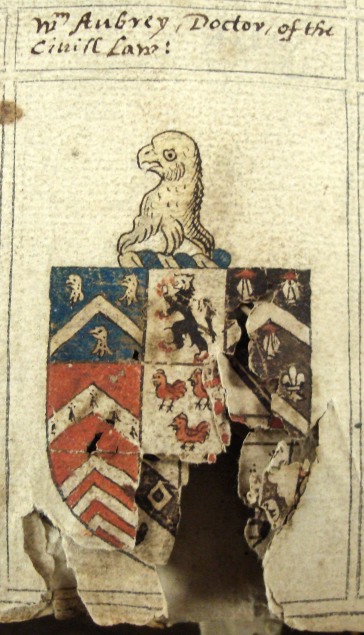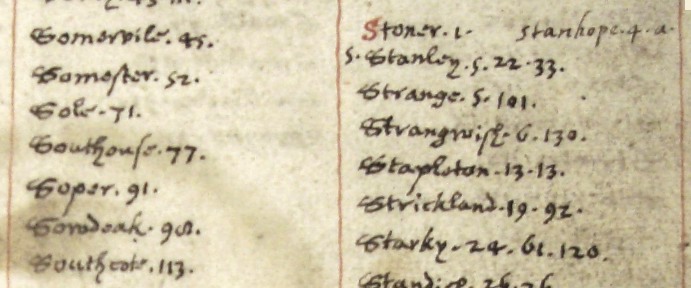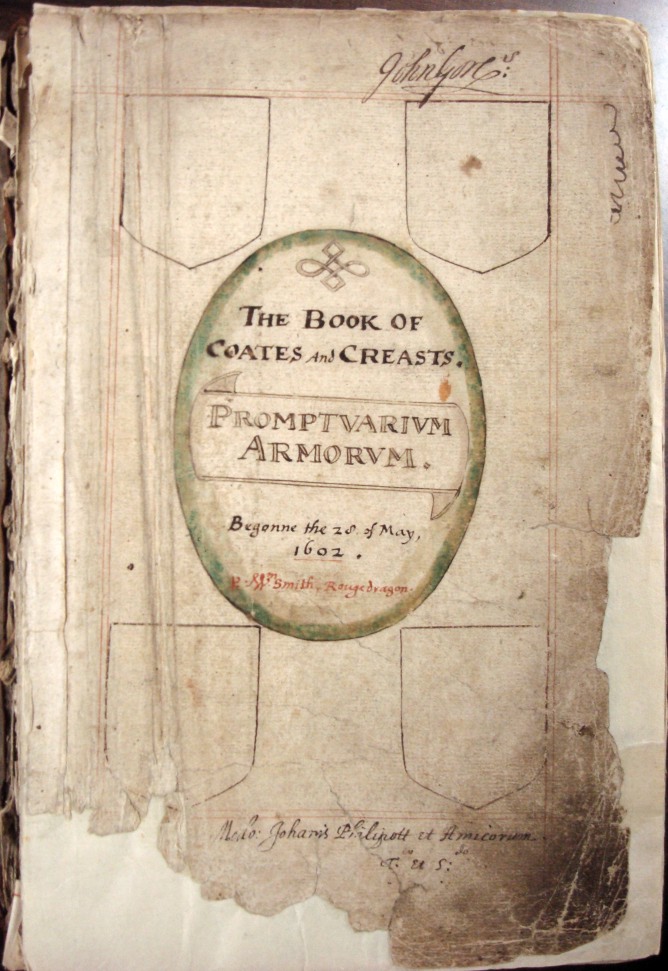Yesterday, in the R. Stanton Avery Manuscript Collection of the New England Historic Genealogical Society (NEHGS) in Boston, I had the chance to look at (and, with the acquiescence of Timothy Salls, the manuscript curator, take a couple of photographs of) the Promptuarium armorum, a heraldic miscellany by William Smith, Rouge Dragon Poursuivant in the College of Arms from 1597 to 1618.

This manuscript’s title page says it was begun in 1602. It has long been known in New England heraldic circles; it belonged to John Gore and Samuel Gore, two heraldic and decorative painters, father and son, who created the ‘Gore Roll’ in the early or mid 18th century. The signatures of the Gores on the Promptuarium give it a strong provenance (though substantial gaps remain). It was in New England at least by the early 18th century, and in this regard is an important colonial document even though it is a book of English arms by an English herald.
I wonder whether anyone (at least here in New England) had previously noticed that the Promptuarium exists in two copies; the other is British Library MS Harley 5807. My purpose in visiting was to get some information about the Promptuarium with which to compare the Boston manuscript with that in London. I was also interested in looking at its condition since I’d heard that it was rendered very frail by chemical corrosion of some of the tinctures through the paper (see above for an example). There is a fair amount of corrosion, seemingly more concentrated near the bottoms of pages (though not exclusively) and nearer the front of the MS (though, also, not exclusively). It also appears that only some (perhaps one?) tincture seem to have caused the corrosion. I did not think to investigate this but looking at the particular arms most affected by the corrosion should lead to the identification of the tincture. Was it or? I’ll have to wait and see. At any rate, the manuscript does seem robust enough to permit a complete overhead photography, perhaps with a view to making it available online.
There are 138 folios of arms, with 32 arms per folio (16 recto, 16 verso), though with the last leaves incomplete. I would guess about 4400 coats.
The Harley copy (as it’s catalogued in the old printed folio Harley catalogue) appears to have more than this: the same 138 folios of arms, indexed at the front (as is the Boston manuscript) plus a second section of 45 leaves (presumably a further 1400 arms).

The Harley catalogue says of that copy: “It afterwards belonged to John Philipot, Herald: then to Rowland Williams, & thence transferred in 1668.” The Boston manuscript has the title in a cartouche with William Smith’s name, followed at the bottom of the page with the added inscription “Modo Johannis Philipott et amicorum T.do & S.do” which I take to be similar to what the Harley catalogue says of the London copy: that it subsequently belonged to Philipott, who with others added to it. Either one could be the ‘original’, and either one a copy of the other, but the London one has additional added arms, presumably by Rowland Williams. The title page of the Boston MS:

Although it is not yet possible to photograph this whole volume, I hope it will be possible to have a complete index in hand soon (duplicate newer handwritten indexes survive with the Promptuarium). I also would like to have a better description and some photos of the London manuscript to see if the question of precedence can easily be resolved. I’d be interested in hearing from any reader in London who can visit the MS; otherwise I’ll rely on a set of CD-ROM scans if the BL is willing to shoot them: that might depend on whether the London copy has suffered the same pigment-related corrosion as the Boston manuscript.
Ideally in the future an edition of the Boston MS of the Promptuarium can join the Gore Roll online; perhaps both can be showcased in the new website for the Committee on Heraldry of the New England Historic Genealogical Society, which is hopefully to appear in the coming year.
Just for fun, I should note the other things from the miscellaneous heraldic collection I had the pleasure of examining yesterday in Boston: the glorious, pristine original 1480 grant of arms by Norroy, with pendant seal intact, to one Christopher Browne of Tolthorpe, Rutland (which was purchased in the 19th c. by an American Browne who erroneously thought he was descended from the grantee); a little charter of a duke of Braunschweig-Lüneburg from 1414, with 4 or 5 small pendant seals; some odd wills and probate documents from the diocese of Worcester in the early 18th century; a set of diplomas and testimonials from the law faculty at the University of Caen (Normandy) in the late 17th century; and finally a grandiose grant of arms, rolled in an oblong red leather box, which I thought at first might be some Victorian letters patent for a peerage (I remember seeing something similar going on eBay last year), but which turned out to be a 1935 honorary grant of arms from the college to a wealthy Bostonian, who must have paid handsomely–handsomely!–for it.

Post a Comment